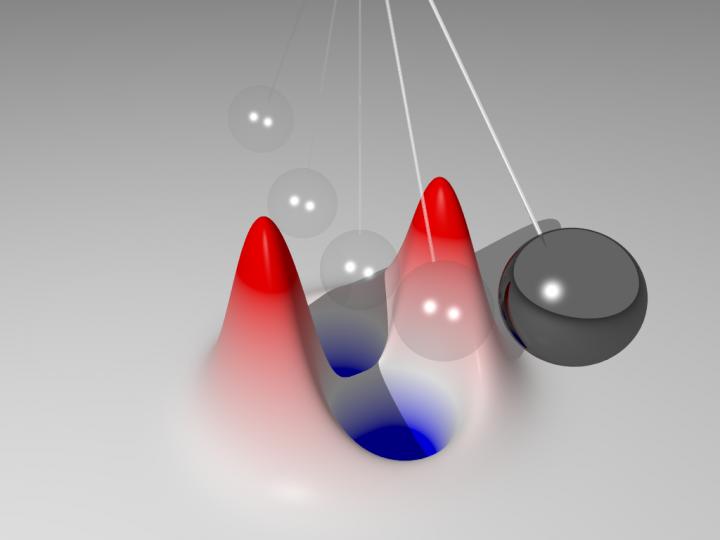Redefining the limits of measurement accuracy

Scientists at the QUEST Institute at Leibniz University, Hannover, and the Physikalisch-Technische Bundesanstalt, have, together with colleagues in Florence, Italy, introduced a method based on a non-classical state adapted to two measurement parameters at once. This will enable precision measurements of molecules which could reveal interactions between conventional and dark matter. Credit: Fabian Wolf/PTB
For centuries, humans have been expanding their understanding of the world through more and more precise measurement of light and matter. Today, quantum sensors achieve extremely accurate results.
An example of this is the development of atomic clocks, which are expected to neither gain nor lose more than a second in thirty billion years. Gravitational waves were detected via quantum sensors as well, in this case by using optical interferometers.
Quantum sensors can reach sensitivities that are impossible according to the laws of conventional physics that govern everyday life. Those levels of sensitivity can only be reached if one enters the world of quantum mechanics with its fascinating properties – such as the phenomenon of superposition, where objects can be in two places at once and where an atom can have two different energy levels at the same time.
Both generating and controlling such non-classical states is extremely complex. Due to the high level of sensitivity required, these measurements are prone to external interference. Furthermore, non-classical states must be adapted to a specific measurement parameter. “Unfortunately, this often results in increased inaccuracy regarding other relevant measurement parameters”, says Fabian Wolf, describing the challenge.
This concept is closely linked to Heisenberg's uncertainty principle. Wolf is part of a team of researchers from Leibniz University Hannover, Physikalisch-Technische Bundesanstalt in Braunschweig, and the National Institute of Optics in Florence. The team introduced a method based on a non-classical state adapted to two measurement parameters at once.
The experiment can be visualised as the quantum mechanical version of a simple pendulum. In this case, the adapted measurement parameters are the pendulum's maximum displacement (amplitude) and the number of oscillations per second (frequency).
The pendulum comprises a single magnesium ion embedded into an “ion trap”. Via laser light interactions, researchers were able to cool the magnesium ion to the ground state of a quantum mechanical system, the coldest achievable state.
From there, they generated a “Fock state” of the motion and oscillated the single atom pendulum using an external force. This allowed them to measure amplitude and frequency with a sensitivity unmatched by a conventional pendulum. In contrast to previous experiments, this was the case for both measurement parameters without having to adjust the non-classical state.
Using this new approach, the team reduced the measurement time by half while the resolution remained constant or doubled the resolution with a constant measurement time. High resolution is particularly important for spectroscopy techniques based on changing the state of motion. In this particular case, researchers intend to analyse individual molecular ions via laser irradiation in order to stimulate molecular movement.
The new procedure will enable them to analyse the state of the molecule before it is disrupted by too intense laser irradiation. “For example, precision measurements of molecules could reveal interactions between conventional and dark matter, which would be a great contribution to solving one of the biggest mysteries in contemporary physics”, says Fabian Wolf.
The measurement concept, which researchers demonstrated for the first time, could also improve the resolution in optical interferometers such as gravitational wave detectors – therefore providing more in-depth insights into the dawn of the universe.
###
The study originated from the collaborative research centre “DQ-mat – Designed Quantum States of Matter”, which is in receipt of funding from the German Research Foundation (DFG). The team of researchers has now published their findings in the scientific journal Nature Communications.
Original article:
Motional Fock states for quantum-enhanced amplitude and phase measurements with trapped ions
Fabian Wolf, Chunyan Shi, Jan C. Heip, Manuel Gessner, Luca Pezzè, Augusto Smerzi, Marius Schulte, Klemens Hammerer, and Piet O. Schmidt
Nature Communications 10
DOI: https:/
Note to editors:
For further information, please contact Professor Piet Schmidt, Physikalisch-Technische Bundesanstalt and Institute of Quantum Optics, Leibniz University Hannover, (Tel. +49 531 592-4700, Email piet.schmidt@quantummetrology.de).
Media Contact
All latest news from the category: Physics and Astronomy
This area deals with the fundamental laws and building blocks of nature and how they interact, the properties and the behavior of matter, and research into space and time and their structures.
innovations-report provides in-depth reports and articles on subjects such as astrophysics, laser technologies, nuclear, quantum, particle and solid-state physics, nanotechnologies, planetary research and findings (Mars, Venus) and developments related to the Hubble Telescope.
Newest articles

NASA: Mystery of life’s handedness deepens
The mystery of why life uses molecules with specific orientations has deepened with a NASA-funded discovery that RNA — a key molecule thought to have potentially held the instructions for…

What are the effects of historic lithium mining on water quality?
Study reveals low levels of common contaminants but high levels of other elements in waters associated with an abandoned lithium mine. Lithium ore and mining waste from a historic lithium…

Quantum-inspired design boosts efficiency of heat-to-electricity conversion
Rice engineers take unconventional route to improving thermophotovoltaic systems. Researchers at Rice University have found a new way to improve a key element of thermophotovoltaic (TPV) systems, which convert heat…



